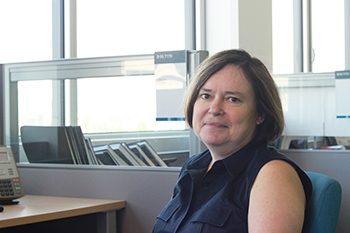The journey of acceptance and determination of a woman living with PKD
From the time she was a young girl, Diane* knew she had a 50/50 chance of having polycystic kidney disease (PKD), an incurable genetic condition in which fluid-filled cysts develop in the kidneys and affect their function. Over time, PKD can lead to renal failure and require dialysis or a kidney transplant. Diane was in her mid-forties when she was diagnosed.
“I inherited the defective gene from my father and saw how badly he coped with his condition, and that’s why I made important decisions early on. I told my doctor I wanted to avoid dialysis and I asked him to put me on the waiting list for a kidney transplant.”
Unfortunately, things didn’t work out quite that way for Diane. She didn’t get on the list fast enough and had to go on dialysis while waiting for a kidney. Throughout that time, Diane hardly missed a day of work as owner of an importing company.
“I would get up very early and go to the Royal Victoria Hospital for the dialysis. I was functioning well and was able to take care of my two kids,” she says. “My condition wasn’t something I wore on my sleeve.”
A diligent approach

According to MUHC Nephrologist Dr. Dana Baran, awareness about Polycystic kidney disease (PKD) needs to be heightened in families where a patient has been identified with the condition.
Diane thinks patients with PKD should be diligent about their disease.
“You have to find the right doctor and ask the important questions. You have to push yourself, because otherwise you’ll reach a point where you’re too sick and have no other choice but to go on dialysis.”
Dr. Dana Baran, a nephrologist at the Royal Victoria Hospital of the McGill University Health Centre (RVH-MUHC) and Diane’s physician, agrees that patients need to be proactive and seek the best and most up-to-date information about their disease.
“Patients with PKD, or with a family history of the disease, should be referred to a tertiary care centre for the first discussions about the condition,” Dr. Baran says. “We also look at medical issues that could have an impact on the progression of the disease.”
According to Dr. Baran, patients should have yearly check-ups, even if they have no symptoms. As more and more cysts develop, the kidney enlarges and symptoms can arise: pain, bleeding in the urine, kidney stones, urinary tract infections and high-blood pressure. After a while, patients can show signs of progressive kidney failure and will need dialysis or transplantation.
A year after she started dialysis, Diane underwent a successful kidney transplant. She must maintain a healthy lifestyle and take anti-rejection medication for the rest of her life. In spite her difficult journey, Diane believes patients living with PKD should never despair.
“PKD, is not just something you can live part-time with,” she says. “But as much as times may get difficult, and decisions may be hard to make, you can have a good life.”
*The name was changed to protect the anonymity of the patient.
New drug brings hope for patients with PKD

“This drug may improve the life of patients with PKD, a disease that has no cure and few other treatment options,” says MUHC Nephrologist Dr. Ahsan Alam, who started prescribing the recently approved drug Tolvaptan to eligible patients in August.
Polycystic kidney disease (PKD) is a genetic condition that affects 35,000 people in Canada and can lead to kidney failure. PKD has no cure, and until recently, patients had no proven treatment options to slow its progression. In August, nephrologists from the McGill University Health Centre (MUHC) started prescribing the pioneering drug Tolvaptan for adults living with PKD.
“Tolvaptan could be an option for patients with relatively good or slightly reduced kidney function,” says Dr. Ahsan Alam, nephrologist at the Royal Victoria Hospital of the MUHC (RVH-MUHC) and assistant professor of Medicine at McGill University. “If we can delay the moment when these patients need dialysis or a kidney transplant, we can improve their quality of life.”
The drug was approved by Health Canada in February 2015, but is not yet covered by Quebec’s drug insurance plan. Its use will be carefully monitored by
Dr. Alam and his colleagues. “Safety is very important,” he says. “These are often young patients who have a long-term disease, so the medication has to be safe enough to be taken for a long period of time.”
Two breakthrough studies
In the last decade, research about the mechanism of PKD and the targets for its treatment has been intense. Out of the several clinical trials that have led to interesting potential avenues, two stand out.
- The Halt-PKD study, published in November 2014, suggests that rigorous blood-pressure control early in the disease process may slow cyst growth.
- The TEMPO 3:4 trial, which involved 1,500 PKD patients with PKD worldwide – including some MUHC patients – tested Tolvaptan.
“The TEMPO study showed that people who took the medication had a slower growth of their kidneys, compared to those who took a placebo,” says Dr. Alam, who was an investigator in the study.
“Patients were waiting for this. Some have seen a family member end up on dialysis or need a kidney transplant; others are concerned about their kids’ future. I’m glad the MUHC contributed to this breakthrough and I hope it will continue to be an ongoing participant in the field of PKD research and treatment.”
